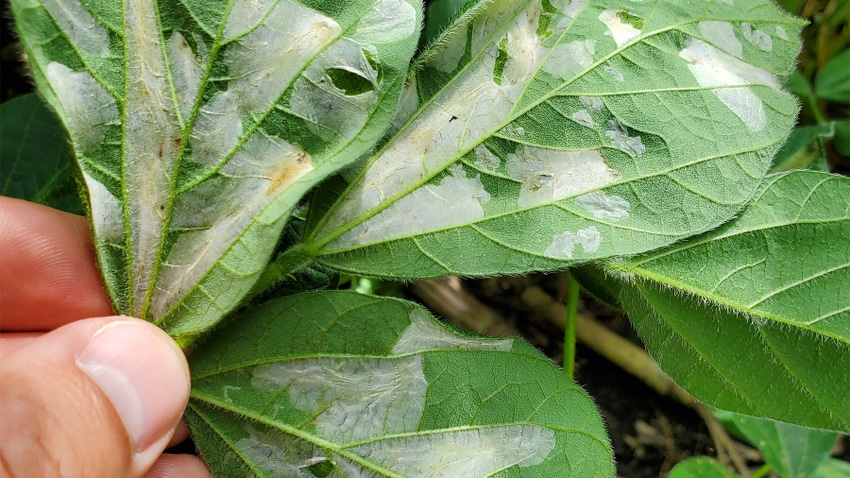February 7, 2024

by Dan Lemke
A native insect that primarily fed on forest plants has developed a taste for soybeans — and that transformation has researchers concerned.
The soybean tentiform leafminer has been discovered in an expanding area of Minnesota, as well as in North Dakota and South Dakota. University of Minnesota Extension entomologist Robert Koch says the insect, first identified in Minnesota in 2021, is a moth that in its caterpillar stage lives inside a soybean leaf. The caterpillar makes a hollow tunnel, called a mine, in the leaf, causing the upper surface of the leaf to buckle up, producing a tent-like growth.
“This is an insect that, as far as we know, has always been in North America, feeding on two rather obscure forest plants,” Koch says. “For some reason, over the last few years, it started to feed on soybeans. It has expanded its host range from feeding on these native legumes that nobody’s really paid much attention to, and now it’s feeding on soybeans, where there are a lot of people paying attention.”
Koch says researchers still aren’t sure of soybean tentiform leafminer’s full potential impact on soybeans. He says research is underway to determine just how widespread the infestation is in soybeans. So far, researchers have detected the pest across a broad area in Minnesota, as well as in both North Dakota and South Dakota.
Within individual fields, Koch says infestations are heavier on the edges, and especially along fields edged with trees. Soybean fields next to forested areas or windbreaks are a likely place to look.
“If there’s a tree-lined windbreak or a forested area next to that field, that edge is likely going to have the highest infestation,” Koch explains.
Because the insect feeds inside the soybean leaf, it destroys tissue, reducing the functional area that can perform photosynthesis. Limiting the plant’s capacity for photosynthesis is how the soybean tentiform leafminer potentially reduces yields.
More to learn about soybean pest
Since the pest was first found in soybeans just a couple of years ago, there is a lot that experts don’t know about the insect. Koch says research this summer will try to help determine how much plant damage it takes to reduce yields.
Initial research has shown that some insecticides are effective in suppressing the insect. Trials have also shown that other legumes like dry beans, chickpeas, green beans and lentils don’t appear on the soybean tentiform leafminer’s menu.
“We don’t really know why,” Koch says, “but what we’re seeing so far is it’s limited to soybeans.”
Koch says researchers are scrambling to learn as much as they can to offer guidance to farmers. So far, scientists don’t know enough about the pest to recommend any treatment options. That situation should hopefully change soon.
“After being in some of these fields, I’m concerned enough about it that I’m investing pretty significant time in trying to figure out what’s going on here,” Koch says. “Some of these field edges in the Minnesota River Valley we’ve been looking at were pretty heavily infested and were pretty torn up by this insect.”
Last summer, researchers started scouting fields when soybeans were in the early vegetative stage. Koch says they were finding eggs and signs of the insects’ presence when there were three trifoliate leaves. Discoveries continued throughout the growing season. Koch expects that multiple generations of the insect develop during the growing season, with their accumulated impacts increasingly noticeably later in the year.
Farmers who discover heavy infestations are encouraged to email Koch at [email protected].
Lemke writes from Madison Lake, Minn.
You May Also Like




